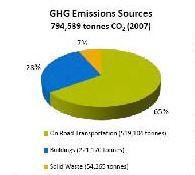Also discussed here: Kelowna & Climate Action(City of Kelowna)
And here: Kelowna’s Community Climate Action Plan Summary of Actions (2012 – 2020)(7 page pdf, City of Kelowna, 2012)
Today we review a climate action plan valid from 2012 to 2020, approved by the City of Kelowna, British Columbia in 2012 and aimed at a 33% reduction of greenhouse gases for the community (the entire city), going beyond the climate plans of many other cities which deal mainly with “corporate” emissions (municipal vehicles and buildings). Kelowna is a small city, located in the Rocky Mountains of western Canada. Over 2/3’s of the greenhouse gas emissions come from vehicles which might be explained by the low population density and large geographical area of the city (it is the same size as Ottawa with ¼ the population) and the highest per capita car ownership of any Canadian city. No surprise then that the main target for reduced emissions is reducing the amount of travelling by car, “right-sizing” (downsizing) the type of car and boosting alternative modes of transportation, as well as managing parking rates and unnecessary idling. It is heartening to see that over 90% of the population support the 20% proposed reduction of vehicle miles driven. Other reductions are proposed for buildings, waste management and land use planning.

Key Quotes:
“The City of Kelowna will, in partnership with: senior governments; local residents and businesses; NGOs; external agencies; and utility providers, work towards reducing community greenhouse gas emissions by 33% (from 2007 levels) by 2020”
“The City of Kelowna is one of 180 out of 188 local governments who have signed the Provincial Climate Action Charter. By signing the charter, the City has voluntarily committed to being carbon neutral in respect of its operations by 2012”
“a Corporate Energy and GHG Emissions Plan.. provided an inventory of greenhouse gas emissions for all City operations (8,317 tonnes in 2007), forecasted emissions for 2017 (10,118 tonnes),…. it is estimated that the City of Kelowna can reduce GHG emissions 22% below its 2007 levels by 2017. Total cost to implement the recommendations is estimated at over $4.5 million."
“ for the year 2007, motor vehicles account for most (over 65%) of Kelowna’s community greenhouse gas emissions. Energy use in buildings accounted for 28% and emissions from solid waste contributed 7%.”
“Kelowna has the highest per capita ownership of light duty vehicles (second highest for heavy duty vehicles) of 33 Canadian municipalities reviewed…having the second highest number of daily trips per capita. This, in conjunction with our high single occupant commuting habits (nearly 80% as single occupant drivers) demonstrates Kelowna is a very car dependent jurisdiction.”
“32.5% of all trips made in Kelowna (excluding going home) were work related, while getting to school accounted for over 9% of trips.” GHG emission sources targeted:
- reducing the amount people drive and changing the types of vehicles residents and businesses use
- Implementing district energy, improving energy efficiency in new and existing buildings and increasing density..
- Achieving the targets set out in the Regional Solid Waste Management Plan
- Land use planning and urban design can influence reductions ..through creating a compact, walkable community”





No comments:
Post a Comment